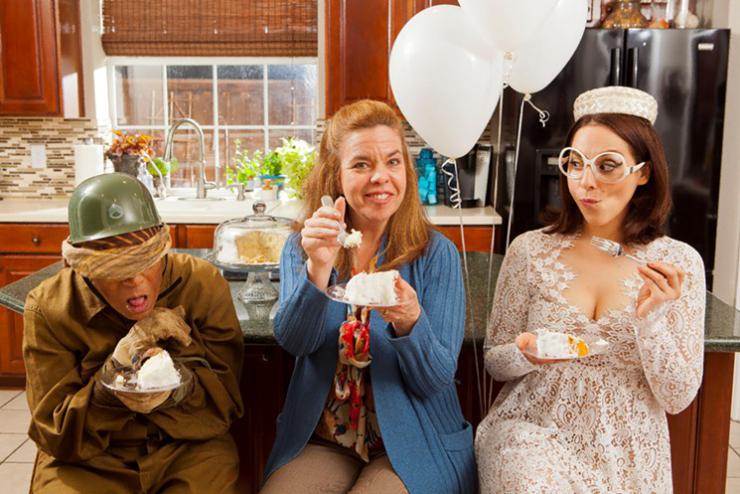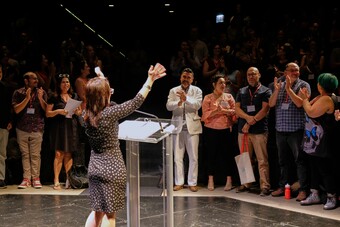The Year of Yockey at Kitchen Dog Theater
It’s a rare opportunity to experience two world premiere plays by the same playwright running in repertory. Dallas’ Kitchen Dog Theater gave their coveted New Works Festival production slot to two premieres of Steve Yockey plays: Blackberry Winter and The Thrush and the Woodpecker. In addition to these productions, they also held a reading of Yockey’s epic Mercury as part of their Festival’s highly competitive reading series (where only six out of over 1000 submitted plays were given a reading). The company raised significant amount of hype in anticipation of these two “hot” plays, including the creation of the hashtag #YearofYockey.
As a rising playwright with multiple productions happening across the country, Yockey has been gaining an increasing amount of attention for his writing. Yockey described his own theatrical interests in this way: I’m a big fan of writing really intimate personal stories that brush up against something epic. And the best way to capture that mythic quality is to use spectacle, like the stage filling with water, or more blood than you’ve ever seen onstage.
Blackberry Winter and The Thrush and the Woodpecker are intimate plays that tackle similar themes. Both are three-handers that present complex representations of women who are creating fictions to cope with their present circumstances. These plays also have an aesthetic connection as they utilize shadow puppetry to present animal fables that connect to each matriarch.
Blackberry Winter and The Thrush and the Woodpecker each present complex representations of women who are creating fictions to cope with their present circumstances.
Blackberry Winter
Stepping into the basement space at Undermain Theatre (where Kitchen Dog abruptly moved after their other venue was shut down by fire marshals), a collection of bannisters with small circular tops surrounds the playing space, each holding a single sentimental item—like a piggy bank, an iron, a sharpie. Scott Osborne’s design suggests that everything has a place on the islands of Vivienne’s mother’s memory. The space feels like an abstraction of home, with just enough detail to look familiar, but no place to rest comfortably.

Vivienne, played by company member Karen Parrish, enters alone with an unopened letter from her mother’s assisted living facility. She is scared to open the letter, as she is sure that it will reveal that her mother should move on to a nursing home, that her Alzheimer’s condition needs greater attention than what they can provide. And that is the crux of the play. Will Vivienne open the letter? Will she confront her fear that her mother must move on to the “next phase” of her life? Vivienne discusses her insecurities in the style of a sincere one-woman show.
Her mother was a very successful baker. Vivienne sorts through her old recipe cards, and reads the entire recipe for a particularly sublime coconut cream cake her mother made before Alzheimer’s took her mind. The play highlights little, idiosyncratic parts of memory and how one loses their humanity in a way, when they forget all the tiny details of who they are. To prove this point, Vivienne invites two actors to the stage.
Instead of having secondary characters to provide conflict or counterpoints to Vivienne’s journey, the other two performers portray Vivienne’s self-made myth, which she created as a coping mechanism make the serious nature of Alzheimer’s bearable. A white woman dressed in a white dress appears alongside a black woman in a brown, tattered jacket and pants. They represent a White Egret and a Gray Mole, and the myth they present in partial verse (which Vivienne proudly declares to the audience) breaks up Vivienne’s monologues about her mother’s condition.
The White Egret has an idea to keep all the memories of the animals locked safe inside a box, that way they will know how to live with each other and maintain order and harmony in the forest. The Gray Mole digs and unexpectedly finds the box through her persistent tunnel creation. She opens it up and the memories of all the animals pour out. The forest goes into chaos, but the Egret remains calm and leads the Gray Mole out.
In between sections of this fable, Vivienne picks up an object in the space that reveals an anecdote about her relationship with her mother. Because there are so few objects on stage, we know that she will discuss each one of them. As the show goes on, Vivenne recalls a memory with each object until one mysterious item remains: a wooden memory box filled with pictures.
Within this fragile story lies an innovative theatrical conceit: stop motion puppetry projections. These projections, designed by David Goodwin, also appear in The Thrush and the Woodpecker, establishing another parallel relationship between these two productions. For Blackberry Winter these projections display a visual representation of the Gray Mole and White Egret’s tale, with jarring shapes and animation. The aesthetics of the projections are similar, with incredibly captivating silhouettes progressing in broken movement, slightly out of joint with the dialogue.
Listening to Vivienne’s memories, we understand she is keeper of not only her mother’s body and livelihood, but her soul. Blackberry Winter ends on a heartbreaking and yet hopeful note. As the play closes, Vivienne finally gets the courage to open the letter from the assisted living facility, determined to accept her mother’s fading condition—because that is all she can do.
Yockey peels the characters apart like onions, revealing deeply powerful and engaging themes of loss and acceptance.
The Thrush and The Woodpecker
The second helping from the #YearofYockey is a mysterious revenge play about a son with two mothers, The Thrush and The Woodpecker. A grimy, windowless living room with a foreboding front door sets the tone for this claustrophobic tale. At rise, an anxious Brenda Hendricks greets the morning with a cup of coffee topped off with whiskey. She lives in a remote area with a high population of woodpeckers that continuously attack the front door.
Brenda’s adult son Noah has been kicked out of an elite college during his senior year for vandalizing outdoor lamps around campus. Noah, an aspiring astronomer, defends himself by pontificating on the ills of light pollution. While Brenda scolds her son for his poor choices, makes reference to a decision she made in the past that some people questioned. The mother-son banter continues until a stranger appears.
The first hint of the supernatural appears when Noah opens the front door and finds Róisín, a woman who claims to be a friend of Brenda’s. Yockey throws in hints of the unexplainable through odd sounds and peculiar lights, hinting that Róisín is no ordinary woman. She begins questioning Noah about his family, stares at him too long, and has a strange panic attack when he leaves to fix some tea.

When Brenda comes back home, she immediately recognizes Róisín. Fearfully, Brenda tells Noah to go fix some of the property’s wind turbines, leaving the two women alone. Róisín confronts Brenda (formerly known as Connie) about stealing her child, Ben (now known as Noah). The major catch in all of this is that Róisín is not here to take her son back. After all Noah/Ben is now a full adult, and the child he was before has disappeared. Róisín is here to wreak pure revenge upon Brenda/Connie. Never mind the small detail that Róisín isn’t alive anymore—she exists in some kind of purgatorial state after killing herself several years ago.
Róisín begins to tell the story of the woodpecker, while the stop motion puppet projections simultaneously illustrate her tale. The woodpecker appeared at a woman’s house, very small, and so tiny he fit inside the woman’s hand. The woman patiently fed the woodpecker day after day until he became too unruly and too large for her to care for. This metaphor could apply differently, though equally to both women’s present situation. Noah is now Brenda’s out of control bird, as the need for revenge is Róisín’s.
Róisín seems to have been with the woodpeckers for a while. She recognizes the taste of maple in her tea, she knows that a group of woodpeckers are called a descent, and she didn’t arrive here by car (perhaps she flew). Near the end of the play, Róisín reveals that a supernaturally massive woodpecker is about to tear Brenda’s house apart. Brenda begs that Noah be spared as she profusely apologizes for her actions, but the lights quickly cut out. Sounds of a monstrous creature and a house splitting apart envelop the audience for the next few moments of complete darkness.
Yockey includes an epilogue. Noah is alive, after all. He mentions that woodpeckers are the only birds that know when they steal another bird’s eggs. However apt this analogy, Noah speaks it from a place of unknowing—his character is still left in the dark.
These two works in repertory succeed in creating complex matriarchal figures who create their own fictions to make sense of their circumstances. The successful elements of these plays concern Yockey’s acumen for character quirks and detailed dialogue. He peels the characters apart like onions, revealing deeply powerful and engaging themes of loss and acceptance.










Comments
The article is just the start of the conversation—we want to know what you think about this subject, too! HowlRound is a space for knowledge-sharing, and we welcome spirited, thoughtful, and on-topic dialogue. Find our full comments policy here